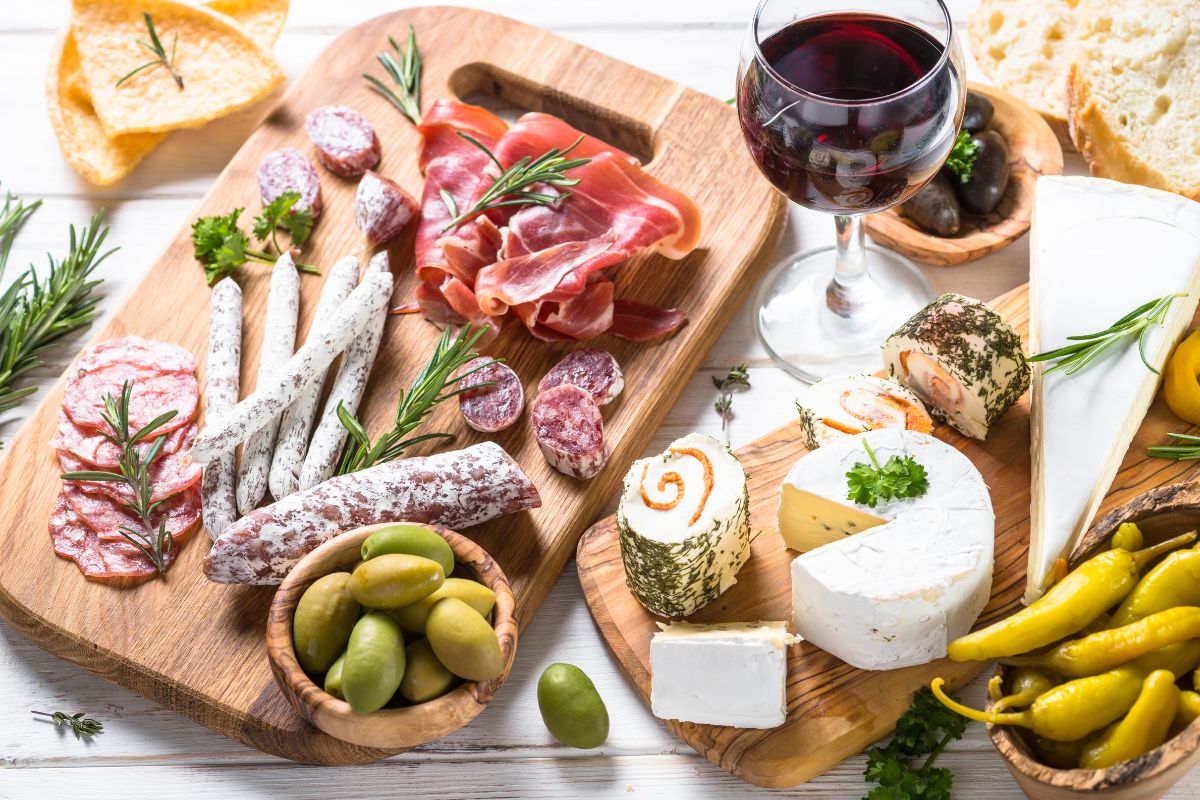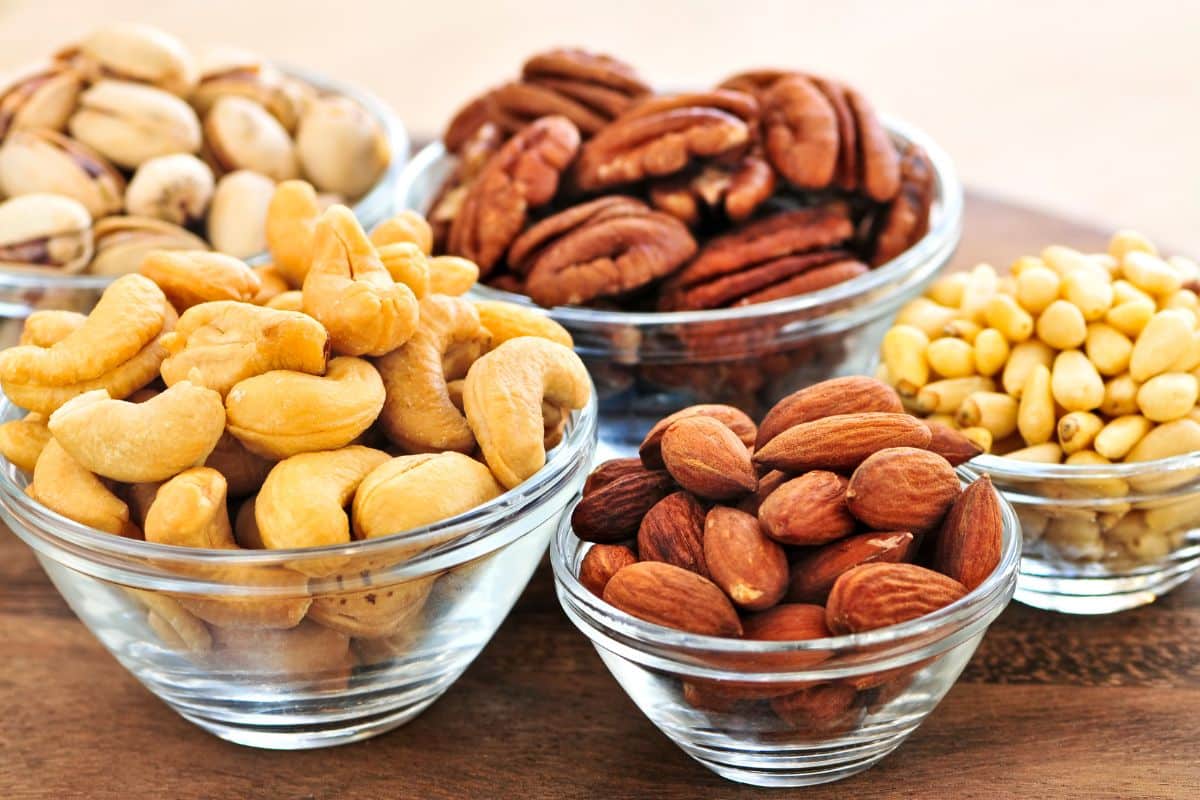If you’re looking for a beautiful and versatile appetizer for your next party, you can’t go wrong with a charcuterie board. This artfully arranged selection of meats, cheeses, and other tasty snacks has something for everyone. And the best part is that it looks like a work of art!

Table of Contents
What is a Charcuterie Board?
The term charcuterie is a French word for cured meat that originated in the 15th century. Modern charcuterie boards typically include a variety of meats, both cured and cooked, plus a selection of cheeses, breads, and other snacks, all arranged on a large board or stone slab. A charcuterie board makes the perfect party appetizer, and with good reason.
It’s Easy – The best part about a charcuterie board is that there’s no cooking, no baking, and no equipment required. Just set everything on your board and let your guests have fun making a delicious appetizer plate.
It’s Beautiful – If you love an Instagram-worthy party table, a beautiful charcuterie board is a must. There are so many beautiful colors, shapes, and textures that it almost looks too pretty to eat.
It’s Versatile – A meat and cheese board is a great opportunity to get creative and include all of your favorite treats. From rich brie and salty nuts to healthy fruit and veggies and fancy jams, a charcuterie board has something that all your guests will love.
It’s Perfect for Parties – Charcuterie boards are ideal when you need to feed a large crowd and don’t have time to cook lots of different appetizers.
There’s really no wrong way to make a charcuterie board, but there are definitely some helpful tips and tricks to make your board look beautiful and ensure that it contains a nice variety of snacks that complement each other. Read on for our favorite charcuterie board ideas, including the art of preparing them and what to serve with them.
Meats
Meats are an essential component of a charcuterie board and I recommend selecting these first, as they will serve as the centerpieces of your board. There are tons of options to choose from, including cured and smoked meats, as well as sliced cold cuts.
Traditional meat choices include prosciutto, Italian dry salami, and Serrano ham, as well as Spanish chorizo, Mortadella, and Sopressata. You can also go with traditional sliced deli meat like chicken, turkey, or roast beef in addition to (or instead of) cured meats. Traditional charcuterie includes a lot of pork products, but I like to make sure I include at least one other type of meat, like chicken or turkey.
Cheeses
Along with the meats, the cheese will be the other focal point of your charcuterie board. You can choose from creamy and soft cheeses like a rich brie or tangy goat cheese to hard cheese like an aged cheddar or a Manchego. There are also delicious smoked options, or cheeses containing herbs, fruits, and spicy peppers. All kinds of different cheeses will work beautifully on a charcuterie platter. Choose a few of your favorite cheeses, aiming for a variety of different shapes, textures, and colors. If you’re using a cheese with a particularly strong flavor, such as a blue cheese, be sure to balance it out with something milder like a Havarti or Swiss.
Breads and Crackers
Your guests will need something to eat with their meat and cheese, so any good charcuterie board will include some kind of bread or crackers. I like to use small pieces of bread that will fit easily on the board, such as thinly sliced baguette pieces. For crackers, I look for varieties with herbs and seeds for visual interest. Breadsticks, cheese straws, and even pretzel rods are some other non-traditional options that will look and taste great on your board.
Jam, Preserves, and Spreads
I like to offer several options for condiments and spreads that will complement the meat and cheese selection on the charcuterie platter. Select a few sweet options, such fruit preserves, honey, fig jam, or cranberry relish. Then add a spicy mustard or mayo for a savory option. You can also add a small ramekin of butter or olive oil for the bread. The sweet options will pair beautifully with the salty cheeses and the other spreads can be paired with the bread and meat to make a mini sandwich.
Olives and Nuts

Olives and nuts are a great way to add variety to your board, and they’re also a great plant-based option for those that don’t eat animal products. You can choose Spanish, black, or Kalamata olives, or use a mixture of different varieties.
Nuts are also a great pairing, bringing out the slightly nutty flavors in your cheese selections. Try serving some pecans, walnuts, marcona almonds, or pistachios. You can choose from the plain salted variety, try some with different seasonings and spices, or use candied nuts.
I like to use small bowls or ramekins for the olives and nuts. This makes for a neater looking board and also allows for easier serving for your guests.
Fruit and Veggies
Fresh fruit and vegetables are a great addition to your charcuterie board, as they add beautiful color and texture. Seasonal fruits and veggies also have the advantage of being a lighter option, and it’s nice to have something for guests who are watching their calories or who just don’t want to fill up on heavy meats and cheeses before the main course.
I like to add carrots and celery sticks, plus some cucumber rounds and cherry tomatoes, and some dill pickles to pair with the meats. Green or red grapes are good choices for a charcuterie board, as they pair well with cheese and they won’t turn brown like apple slices. Fresh figs are another favorite, and raspberries are a great option for their vibrant red color.
And don’t forget about dried fruit. Candied pineapple and dried apricots are some of my favorite choices to satisfy your sweet tooth, and they also pair well with lots of cheeses.
Decorative Touches
Once you’ve selected all the snacks for your board, it’s nice to add a few decorative touches. Fresh herbs are great for this – you can strategically place a few sprigs of fresh rosemary or bunches of chives around the board to add some pretty green color and make it look extra fancy. If you’re making your charcuterie board for a holiday party, placing a few fresh cranberries around the board is also a great idea. You can even accessorize with flowers. Use your imagination and get creative with ideas to make your board more festive.
How to Build Your Board
Now you’re ready to assemble your charcuterie board, and although this part is simple, it’s not quite as simple as just placing everything on the board any which way you want. There are a few basic rules you should follow if you’re looking to really wow your guests with a beautifully presented board.
Choose the Right Board – You’ll need a sturdy and flat surface for building your board. I recommend using wood, ceramic, or slate in a large rectangle shape. Avoid textured surfaces or anything with an odd or irregular shape.
Place the Meats and Cheeses First – I generally like to select about three meats and three cheeses, although you can certainly do more if you’re making a really big board. Place them on the board first, spacing them out evenly, with room in between so you don’t have any 2 meats or cheeses right next to each other.
Add Larger Items First – place anything else that’s large or irregularly shaped on the board first, and add mini jars of jam or mustard, or bowls of olives and nuts, to ensure that there’s room for all of them. Smaller items like piles of dried fruit and smaller crackers can then be used to fill in the empty spaces.
Fill All Available Space – Nothing detracts from the look of your board like empty spots, so go ahead and pile everything high, making sure your snacks overlap and you can’t see the bottom of the board.
Add Decorative Touches – These items can be placed last like a garnish for your board and can also help you fill in any last bits of empty space.
Wine Pairings
Choosing the perfect wines to pair with your charcuterie board can be a challenge since there are so many different flavors and types of food that your guests can choose from. I recommend selecting wines that will pair well with the main components of your board – the meats and cheeses.
Bold Reds – Try a full-bodied red wine to pair well with the smoky flavor of cured charcuterie meats. Cabernet Sauvignon, Zinfandel, and Malbec would all be excellent choices.
Champagne and Other Sparkling Wines – Champagne is always a good choice for a party as it makes any event feel like a special occasion. I particularly like to serve champagne during the holidays, and its high acidity and ability to pair well with salty foods makes it a great choice to serve with a charcuterie board. If you’re looking for a more budget friendly bubbly, try a California sparkling wine, a Spanish cava, or an Italian prosecco.
Now that you’ve got plenty of tasty ideas and tips to build the perfect charcuterie board, I hope you’ll give this crowd-pleasing party appetizer a try at your next gathering. With so many delicious and hearty options all in one place, this may be the only party appetizer you’ll ever need! Have fun creating beautiful and delicious new variations, and don’t forget to snap a photo for social media!







Leave a Review!